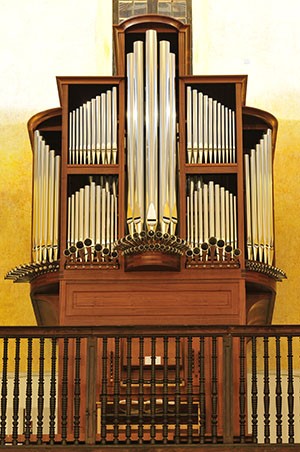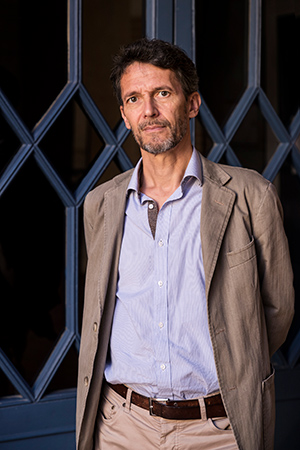 Tuesday, October 22, 9.30 pm
Tuesday, October 22, 9.30 pm
Church of São João Evangelista (Colégio)
The art of transcription
Yves Rechsteiner, organ
Grande órgão
Johann Sebastian Bach (1685-1750)
Partita III, BWV 1006, for solo violin
Preludio
Loure
Gavotte
Menuet I et II
Bourrée
Gigue
Jean-Philippe Rameau (1683-1764)
Suite em ré
Entrée
Menuet
Air pour les Fleurs
Air «Tendres amours»
Rigaudon12
Domenico Scarlatti (1685-1757)
Sonate en sol, fuga, K 30
Sonate en sol, andante K 144
Sonate en sol, allegro K 119
Jean-Philippe Rameau
Suite en la
Sarabande
Tambourins
Air tendre
Gavotte
Johann Sebastian Bach
Chaconne
(Partita I, BWV 1004, for solo violin)
All transcripetions and arrangements by Yves Rechsteiner
This programme pats homage to three great organists and composers of the 18th century from three musical traditions: France, Germany and Italy. Almost all the works presented in this concert are arrangements of pieces written originally for other instruments. Some explanations follow.
Jean-Philippe Rameau, known as the most important opera composer in France in the 18th century, began his musical career as an organist in a number of cathedrals. However, he never composed a single work for organ. On the basis of a study of his harpsichord music and the style of French organists of the period, I made arrangements of some of the best-known passages from his operas. This practice was already current at the time, since we know that his pupil Claude Balbastre played arrangements of works by Rameau on the organ at the Concert Spiritual, the first concert hall in Paris in the 18th century.
Domenico Scarlatti was a virtuoso on the harpsichord. In a contest with Handel on organ and harpsichord, the audience declared Scarlatti the better harpsichordist and Handel the better organist. In spite of some sonatas which appear to have been written for chamber organs, Scarlatti wrote nothing for the church organ. However, his style is perfectly adapted to the sonic possibilities of the Iberian organ and we also see the influence of Scarlatti in the music of José Lidon, organist of the Royal Chapel of Madrid, as well as that of Sebastián Albero, a particularly original figure of this period.
Johann Sebastian Bach is certainly the most important composer ever for organ. However, I have concentrated over the years on the sonatas and partitas that Bach wrote for solo violin, and, indeed, it is known that he himself played them on the keyboard. We are fortunate enough to have some surviving passages from these arrangements made by Bach, and they served as models for my project Bach Metamorphosis 2020, a version for organ which I made of all the sonatas and partitas for solo violin. I perform in this concert the lovely Partita III, as well as the Chaconne from Partita I, one of his most famous works, also transcribed for piano by figures such as Busoni.
Yves Rechsteiner
Participants
|
Born in Switzerland, Yves Rechsteiner studied organ and harpsichord at the Schola Cantorum Basiliensis. A prize-winnder at various international competitions, he has taught baroque keyboard accompaniment since 1995 at the National Conservatory of Music and Dance of Lyon, where he is also the director of the Department of Early Music. Much concerned with reflecting on organ music, he devised concert programmes with his own arrangements of works, whether baroque, classical or symphonic, or rock: Rameau, Bach, Haydn, Mozart, Berlioz, Frank Zappa and Mike Oldfield. Since 2005 he has performed as a dup with the percussionist Henri-Charles Caget and in a trio with the guitarist Fred Maurin. An admirer of different musical meetings, he collaborates with musicians from various musical worlds (traditional, jazz, classical, baroque). Since 2014 he has directed the Toulouse des Orgues festival, in which he aims to open the festival to all musical styles, including contemporary and electronic music. |
Notes about organ
Church of São João Evangelista (Colégio), Funchal
This instrument, with 1586 sounding pipes, is situated in a religious space with certain particularities. As a church typical of those belonging to Jesuit colleges, with a broad nave and quite a gentle acoustic, the organ had to be specially conceived, especially with regard to the measurements of the pipes. Thus all the pipework of the instrument has been specifically tailored to produce a full sound, and each stop produces a timbre with an individual personality, forming part of a harmonic ensemble based more on the sound of fundamentals and less on harmonics. It was also felt to be essential to give the instrument a certain ‘latin’ sonority that would favour performance of ancient music of the Italian, Spanish and Portuguese schools of the 17th and 18th centuries.
Another aspect to be taken into consideration was the need to complement the current range of organs available locally: the new organ responds in an ideal fashion to the performance of works of periods and of technical and artistic requirements that none of the 24 historic instruments of Madeira cater adequately for. It also enhances the range of organs that constitute the island’s heritage by being present in this particular religious space, as well as by existing side by side with other historical instruments. In the decision to build it for this church, not only were the issues of acoustic, aesthetic and liturgical space taken into account, but also the presence there of an important historic instrument which is currently on the list of instruments undergoing restoration.
I Manual - Órgão Principal (C-g’’’)
Flautado aberto de 12 palmos (8’)
Flautado tapado de 12 palmos (8’)
Oitava real (4’)
Tapado de 6 palmos (4’)
Quinzena (2’)
Dezanovena e 22ª
Mistura III
Corneta IV
Trompa de batalha* (bass)
Clarim* (treble)
Fagote* (bass)
Clarineta* (treble)
II Manual - Órgão Positivo (C-g’’’)
Flautado aberto de 12 palmos (8’)
Tapado de 12 palmos (8’)
Flautado aberto de 6 palmos (4’)
Dozena (2 2/3’)
Quinzena (2’)
Dezassetena (1 3/5’)
Dezanovena (1 1/3)
Címbala III
Trompa real (8’)
Pedal (C-f’)
Tapado de 24 palmos (16’)
Bordão de 12 palmos (8’)
Flautado de 6 palmos (4’)
Contrafagote de 24 palmos (16’)
Trompa de 12 palmos (8’)
Couplers
II/I
I/Pedal
II/Pedal
* horizontal reeds
 Yves Rechsteiner
Yves Rechsteiner